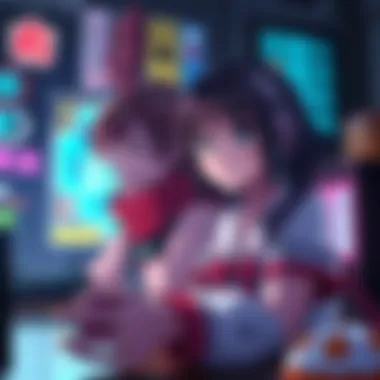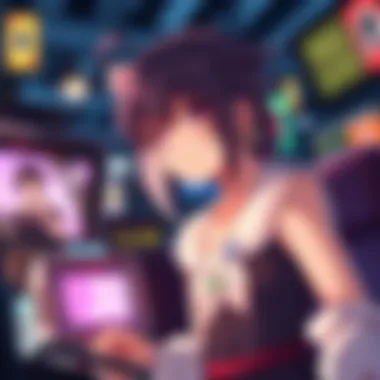Heroes, Harem, and Guilds: Cheats in Anime Gaming


Intro
In the fascinating world of anime-themed games, the convergence of heroes, harem sagas, and guild interactions creates a rich tapestry that captures the imagination of players. These diverse elements drive not only engagement but also stir discussions around ethical gameplay practices, particularly in the ever-contentious realm of cheats. To understand this intricate relationship, we must first dissect the core components influencing player experiences and the evolving landscape of technology that supports these dynamics.
Anime games often take inspiration from popular tropes found in various series, where heroes rise to face challenges, harem dynamics create romantic tension, and guilds foster community through teamwork and collaboration. The introduction of cheats, whether used to gain advantages or explore storylines more thoroughly, adds a layer of complexity that keeps discussions alive in online forums and social media. What are the implications of using cheats, and how do they affect not just gameplay but the broader anime gaming culture? This article sets out to explore these questions while providing insights into how these themes intertwine and shape the player's journey.
Through a careful analysis of popular games infused with these elements, combined with exploration of player psychology and societal norms surrounding gaming, the discussion will unfold. What fascinates players about heroes overcoming great odds? How do harem narratives play into their choices, and what role do guilds serve in this ecosystem? Expect a deep dive into the dynamics of cheats in this context, enhancing both understanding and appreciation of these multifaceted themes.
Let’s begin by examining a critical aspect that enhances game experiences: the features of popular anime apps.
Intro to Anime Gaming
Anime gaming has evolved into a rich landscape, intertwining storytelling, character depth, and engaging gameplay. It serves not only as entertainment but as a cultural phenomenon that reflects diverse narratives and fantasies. Understanding this unique niche is crucial, since it sets the stage for exploring heroes, harem dynamics, guild structures, and the use of cheats.
The Evolution of Gaming in Anime Culture
The journey of anime gaming can be traced back to the early days of video games, where pixelated characters were the avatars of popular anime shows. The integration of anime aesthetics like vivid colors, unique art styles, and intricate character designs has continued to evolve. From the simple 8-bit games, players now find themselves immersed in worlds that feel alive, thanks to advancements in graphics and storytelling techniques.
- In the 90s, games like Akira: Psycho Ball saw a significant rise in popularity.
- Fast forward to the 2000s, where titles like Naruto: Ultimate Ninja series pushed boundaries with immersive storytelling.
What stands out in this evolution is how these games have managed to leverage plotlines and characters from anime. By doing so, they create an experience that resonates deeply with fans, making them feel an intrinsic connection to the narrative��—often blurring the lines between watching an anime and playing a game.
Defining Key Themes: Heroes, Harem, and Guilds
In this section, it is essential to grasp the prevalent themes in anime gaming. Understanding these themes will allow us to appreciate how they enhance gameplay and player experiences.
Heroes
Heroes are the embodiment of aspiration in many anime games. They often face monumental challenges—be it battling evil empires or embarking on transformative journeys. Their characteristics often encapsulate bravery, resilience, and a strong moral compass.
- Anime games are usually centered around these heroes, engaging players in quests that test their mettle.
Harem
Harem dynamics introduce complexity into narratives. Players form relationships with multiple characters, offering not just romantic paths but also building alliances that affect gameplay. This duality allows players to engage with diverse storylines, enhancing replayability.
Guilds
Guild systems often reflect real-world community dynamics. Players team up to tackle challenges, pooling their resources and skills. This collaboration mirrors how friendships can blossom within groups, creating not just a gaming environment but a thriving social network.
Understanding the Hero Archetype
The hero archetype is a bedrock of storytelling, especially in anime gaming, where players often immerse themselves in fantastical worlds. This section will explore the importance of understanding the hero archetype within anime games. The hero acts as a vessel through which players experience the narrative, making the role both pivotal and profound.
Characteristics of Heroes in Anime Games
In anime gaming, heroes can take on a variety of forms, each embodying distinct characteristics that resonate with players. Common traits include bravery, resilience, and an unwavering sense of justice. Here are some fascinating features that often characterize these heroes:
- Relatable Flaws: Unlike perfect beings, many heroes come with flaws that endear them to the audience. Take Kirito from Sword Art Online, whose initial lack of social skills evolves as he learns to connect with others.
- Physical and Magical Abilities: Anime heroes often wield unique powers, be it through martial arts, magic, or enchanted weaponry. For example, Natsu Dragneel from Fairy Tail utilizes fire-based spells, making him captivating and memorable.
- Dynamic Backstories: A hero's journey often involves a transformative backstory. Shinji from Neon Genesis Evangelion grapples with his past, which shapes his identity throughout the game.


These traits not only create compelling characters but also enhance the player's emotional investment in the story. When players find attributes that echo their own experiences or aspirations, it deepens their connection to the game.
The Role of Heroes in Player Engagement
Heroes serve as more than just protagonists; they are instrumental in fostering player engagement. Through the lens of the hero, players undergo challenges, explore rich worlds, and form meaningful connections. Consider the following aspects that highlight the hero's role:
- Identification and Empathy: Players often see themselves reflected in the hero's struggles and triumphs. This connection can be very powerful, igniting feelings of empathy that keep players engaged.
- Motivation for Gameplay: A well-crafted hero motivates players to overcome obstacles, striving towards goals and achievements within the game. For instance, when a hero overcomes adversity, players are driven to match that determination.
- Narrative Progression: Heroes guide the story's progression. Players might unlock new levels or plot points through their actions as heroes, creating a rewarding loop that keeps them returning for more.
"The hero's journey is a mirror for players, reflecting their aspirations and challenges in a virtual world."
Thus, understanding the hero archetype is vital for both the creators and players of anime games. It shapes not just the narratives but also diversifies gameplay and experiences, creating a tapestry of interaction that captivates the audience.
By dissecting the essence of heroes in anime gaming, one can appreciate the underlying mechanisms that foster player engagement and the longevity of the genre. To navigate this intricate realm effectively, comprehension of the hero's role becomes essential.
Harem Dynamics in Gaming
The inclusion of harem dynamics in anime gaming serves not just as a plot device, but also as a complex representation of relationships and character development. It brings with it a certain charm that attracts many players, particularly those who are fans of anime and its multifaceted narratives. In essence, harem elements create a tapestry of interpersonal relationships that add richness to the gaming experience. By exploring these dynamics, we can uncover how they enhance player engagement and storytelling, ultimately elevating the enjoyment and immersion within the game.
Exploring Harem Configurations
The configurations found in harem settings can range broadly, varying from large groups of love interests to more intimate scenarios where one protagonist is surrounded by a handful of characters. Each arrangement offers unique advantages and challenges, shaping how players interact with narrative elements.
- Character Profiles: Each character in a harem setting often has distinct personality traits and story arcs, allowing players to connect with diverse narratives. For instance, take the game "The World God Only Knows". Here, the main character, Keima Katsuragi, is tasked with capturing the hearts of various girls, each with their own backgrounds and conflicts. This creates an engaging gameplay loop where players delve into each character's life.
- Choice Dynamics: Players often face choices that not only affect their relationships but can also change the course of the story. Navigating through dialogues, making decisions, and seeing how they impact character outcomes is a cornerstone of harem games, fostering a sense of agency. A notable example is "Date A Live", where the player's interactions significantly influence the trajectories of the heroines.
- Emotional Stakes: Harem games allow exploration of romance and friendship, amplifying emotional stakes. As players progress, they often feel a connection with the characters, which increases the investment in the game's outcome. In "My Teen Romantic Comedy SNAFU", players get both comedy and serious themes, creating a mature complexity in the harem narrative.
Impact on Storytelling and Gameplay
The integration of harem dynamics has a significant impact on both storytelling and gameplay mechanics.
- Narrative Depth: Harem narratives often tackle themes of love, belonging, and conflict. The relationships are painted with emotional depth, leading to moments of tension and resolution that keep players hooked. In a game like "Neptunia: Action Unleashed", the harem aspect melds with action, allowing for a unique narrative progression that feels engaging and fresh.
- Gameplay Mechanics: Harem configurations often affect gameplay through relationship-building mechanics, such as dating simulations or combat synergies. Characters with stronger relationships may grant players specific abilities or bonuses, enriching strategy. In games like "Senran Kagura", these relationship mechanics influence character performance and player strategy during combat.
- Player Choice and Agency: The blend of harem dynamics and player choice creates a strong sense of agency. Players are not just passively experiencing the story, but actively shaping it as their decisions dictate character paths. This can lead to multiple endings, providing replayability and ensuring that players feel their input truly matters.
Harem dynamics, while often underappreciated, serve as a bridge between narrative depth and engaging gameplay, pressing players to think critically about their choices and their impact on virtual lives.
The Guild System: Community and Collaboration
The social fabric of anime gaming is often woven with threads of community—none more significant than the concept of guilds. These virtual collectives serve not just as a platform for collaboration but also as a catalyst for deep engagement within games. Guilds are where players come together to tackle challenges that feel insurmountable when taken on alone. Through guilds, players exchange strategies, share resources, and foster friendships, all of which enhance the gaming experience. \
Defining Guilds in Anime Games
In the realm of anime games, a guild is tantamount to a virtual club. Players band together under a common banner, bearing unique identities that resonate with various themes or goals. For example, in games like Sword Art Online: Integral Factor, players join guilds called "Parties" to battle together, sharing weapons and skills.
Whether they are called clans, teams, or simply guilds, these groups provide structure to the community experience. The defining feature of a guild is its capacity for collaboration, where members strategize over in-game quests and objectives.
- Roles within Guilds:
- Common Objectives:
- Leaders coordinate activities and guide strategy.
- Collectors gather resources essential for guild missions.
- Warriors engage in combat to protect the guild's reputation.
- Completing quests and defeating bosses.
- Participating in events or tournaments that bear guild prestige.
- Achieving rank advancements that reflect guild success.
Guild Mechanics: Cooperative Play and Competition
Guilds also facilitate a dual nature of gameplay—cooperation and competition. On one hand, members work together to enhance their skills and resources, breaking down walls that one might encounter in solo play. Through shared efforts, players can tackle more challenging content than they could alone.


On the flip side, competition among guilds is fierce. Games often implement ranks, leaderboards, and events that pit guilds against each other. This competitive aspect drives many players to improve, both individually and as a unit, creating an environment that thrives on mutual encouragement and rivalry.
"The thrill of achieving a shared goal, whether it’s defeating a formidable foe or reaching a milestone, can't be overstated. It creates bonds that mere matchmaking cannot replicate."
This competitive spirit is equally a catalyst for innovation in strategies and tactics, leading to an evolution of gameplay as guilds strive to outdo one another. The mechanics thus foster an intricate dance where collaboration and competition coalesce, enhancing the vibrancy of the entire gaming experience.
Cheats: A Tool for Enhancement or a Road to Corruption?
In the world of anime gaming, cheats often occupy a controversial space that straddles the line between enhancement and ethical breaches. On one side, cheats can serve as a gateway to experience the narrative and mechanics of a game without the inconvenience of grinding, thereby enriching the gaming experience. For instance, titles that incorporate intricate storylines, like Sword Art Online, might feel especially compelling when players can skip tedious fetch quests or unlock powerful abilities with a simple cheat code.
However, this access invites significant scrutiny. As more players engage with cheats, it can dilute the original intent of the game, transforming a shared challenge into a lopsided encounter. This raises an essential question: do cheats foster enjoyment, or do they ultimately lead to an erosion of fair play?
In exploring this dichotomy, one encounters various considerations. While many players view cheats as a harmless way to enhance their enjoyment, others feel it fundamentally undermines the game's integrity. The narrative engagement can suffer if players progress at an unnatural pace, striking a balance between enjoyment and integrity is crucial for preserving the essence of gaming.
Types of Cheats Available in Anime Games
Cheats in anime games can come in many flavors, each designed to tweak gameplay elements to a player's advantage. Some of the most common types include:
- Code-based Cheats: Traditional cheat codes entered via the game interface—think Konami Code for enhanced health or lives.
- Trainer Software: Programs that run alongside a game, allowing players to change game variables such as speed, enemy health, or item acquisition.
- Mods: Modifications made to the game's code or files, often creating entirely new experiences or unlocking hidden content not meant for general access.
- APKs: For mobile platforms, alternate source app installations offer cheats when original game designers have not anticipated them.
For example, players of the mobile game Fate/Grand Order often turn to mods designed to enhance drop rates or experience gain, enabling faster character development compared to a grind-heavy playthrough.
The Ethical Debate Surrounding Cheat Usage
The ethics associated with cheat usage remain hotly contested, and their implications warrant careful examination. While the belief that everyone should enjoy their gaming experience is widely accepted, what happens to those who invest time and effort into progressing the traditional way?
Consider these dimensions in the ethical debate:
- Enjoyment vs. Fairness: Is it justifiable for some to advance effortlessly while others struggle through the game? This harbors deep implications for community dynamics and player satisfaction.
- Impact on Developers: When players opt for cheats, developers may receive skewed feedback, impacting future game balance or even leading to the demise of beloved titles.
- Player Choices: Can utilizing cheats be framed as a legitimate choice? If a player’s objective diverges from gameplay norms, does this compromise the integrity of the experience?
Ultimately, it's a double-edged sword. While cheats can offer shortcuts to enjoy the rich storytelling found in anime games, they can also harbor consequences that benefit some at the expense of others, raising ethical questions that may affect the gaming community for years to come.
"The rise of cheats exemplifies a clash of desires—between the need for challenge and the yearning for enjoyment."
Technological Implications of Cheats
In the fast-paced world of anime gaming, cheats have become a significant part of the landscape. Their prominence raises numerous issues and considerations, especially in relation to technology. In this section, we will explore how technology has facilitated the rise of cheats, its impacts on gameplay, and the security challenges that come along with it.
The Rise of APKs for Cheat Accessibility
With the advancement of mobile technology, APKs—the installation files for Android applications—have become increasingly popular among gamers looking to gain an edge. Downloads and installations of cheating software have shot up like a rocket, as these APKs provide easier access to cheats compared to traditional desktop methods.
This ease of access can be attributed to a few key factors:
- Simplicity: Most users need not be tech-savvy. A few taps on a device, and they could be equipped with powerful game-assisting tools.
- Anonymity: The mobile platform allows for more discreet adoption of cheats. Players can engage in their gaming shenanigans without drawing the same level of attention as they would on a PC.
- Community Sharing: Many anime gaming forums and social media platforms are plastered with APK links. Users share their findings, creating a culture where acquiring cheats is as common as swapping game tips.
However, while many jump on the bandwagon, some may be unaware of the potential risks involved when downloading APKs. There’s a fine line between enhancing gameplay and exposing oneself to malware or viruses. Therefore, it’s crucial for players to tread carefully.
Security Concerns and Anti-Cheat Measures
As the appetite for cheats grows, developers are not sitting on their hands. They are ramping up efforts to counteract cheating via innovative anti-cheat technologies.


These security measures aim to protect the integrity of the gaming environment, and they include:
- Machine Learning Algorithms: Developers use these algorithms to analyze player behavior and detect anomalies. If a player moves faster than normal or gains points at an unnatural rate, red flags fly up.
- Regular Updates: Frequent patches and updates to the game not only enhance features but also address known cheat vulnerabilities, keeping the playing field balanced.
- Player Reporting Systems: Some anime games now implement community-driven reporting systems where players can flag suspected cheaters. This adds an extra layer of oversight.
Despite these efforts, it often feels like a game of cat and mouse. Cheaters are quick to develop new methods, leaving developers scrambling to catch up.
"As technology continues to evolve, so too does the arms race between cheats and security measures. The challenge lies not just in creating fun experiences, but also in safeguarding them from exploitation."
The juxtaposition of enhancing gameplay versus maintaining fairness creates an ongoing moral dilemma. Players who indulge in cheats may find short-lived enjoyment. Yet, it raises questions about their commitment to the game and the community as a whole.
In summary, the technological aspects surrounding cheats in anime gaming are complex. The rise of user-friendly tools like APKs makes cheats readily available, but that ease comes with risks. Concurrently, as developers employ new security measures, the tug-of-war between enhancing gameplay and preserving its integrity rages on. The implications here span far and wide, from individual player experiences to broader community dynamics.
Player Perspectives on Cheats
In the realm of anime gaming, the dialogue surrounding cheats is as diverse as the genres themselves. The topic of player perspectives on cheats plays a critical role in understanding the cultural and psychological implications of gaming experiences. Here, we delve into how players perceive cheats—not just as lines of code or shortcuts, but as integrative parts of their gaming journey. Players navigate a spectrum of feelings regarding fair play, enjoyment, and the hidden costs of utilizing cheats. This balance makes it essential to reflect on how personal values and community standards shape one’s view of these tools.
The Divide: Fair Play vs. Enjoyment
The tension between fair play and enjoyment is a defining aspect of the gaming landscape. On one hand, players advocate for fair play, viewing cheats as undermining the integrity of both games and the communities built around them. For instance, if a player uses cheats to breeze through a challenging section of a game, some might contended that it diminishes the accomplishment felt by those who embrace the grind.
Conversely, many players argue that cheats can enhance enjoyment, offering various perspectives:
- Accessibility: Cheats can make games more accessible to players with varying skill levels, allowing them to engage with content that otherwise might be out of reach.
- Creativity: Some players use cheats to explore aspects of the game that were not intended by developers, creating unique experiences, such as altering character appearances or testing new strategies without the constraints of normal gameplay.
- Replay Value: Cheats can revitalize a game, encouraging players to return after completing it or to try different playstyles.
This dichotomy reveals a complex relationship with cheats—where one player’s enhancement is another player’s heresy. This can lead to heated debates in forums like Reddit or within gaming communities on platforms such as Facebook, highlighting how deeply personal these experiences are.
Case Studies: Player Experiences with Cheats
Exploring actual player experiences with cheats provides a grounded understanding of their impact. A few notable examples include the following:
- Final Fantasy XIV: A MMO that has seen controversies surrounding bots and cheats. Players often express frustration, noting that while these tools can clear difficult raids, their presence diminishes the sense of achievement for others. Conversely, some players insist that using guides and helper programs can enrich their enjoyment of the game, especially when they struggle to keep pace with friends.
- Persona 4 Arena Ultimax: In this fighting game, cheats can unlock all character moves and stages instantly, allowing players to focus on mastering their favorite character rather than grinding through battles. Players report that it enhances their understanding of the game mechanics quickly and enables competitive play, which many find more satisfying than traditional methods.
- Stardew Valley: Many players utilize cheats to experiment with farm layouts or manipulate time, showcasing how some gaming sessions can morph from serious to whimsical without sacrificing fun. Such a practice demonstrates that the ability to modify gameplay fosters creativity and exploration.
Through these case studies, it's clear that player perspectives on cheats can vary widely, depending on personal experiences, community norms, and the type of game involved. As the debate rages on, the cultural significance of cheats remains a fascinating topic within anime gaming circles.
Ending: The Future of Heroes, Harem, Guilds, and Cheats
In an arena bustling with anime gaming, the merging of heroes, harem narratives, and guilds into gameplay presents significant implications for the future. As players increasingly engage with these elements, the complexity of their interactions is set to grow. This analysis underscores the need to understand how these themes not only define gaming experiences but also reflect broader cultural shifts and player desires.
The significance of this topic lies in its exploration of identity and community within gaming. Heroes not only serve as avatars for the player but also embody ideals and aspirations, often reflecting societal values. As the notion of the hero evolves, we see characters increasingly infused with complexity, striding beyond the archetypes of greatness and more into realism, which resonates deeply with modern players.
Harem dynamics, too, are indicative of changing societal norms around relationships and connection. Gamers are looking for stories that explore intricate social interactions, not just straightforward progressions through quests. The romantic subplots enhance player investment while also investing in the narrative's emotional weight.
The guild systems foster collaboration but can also create rivalries, reflecting real-world social structures. Understanding guild mechanics will provide insights on how players navigate community dynamics, potentially influencing future game designs.
Predictions for the Evolving Landscape of Anime Gaming
Looking ahead, one can predict a blossoming landscape for anime gaming shaped by innovation and player feedback.
- Increased Personalization: Gamers, especially in the anime niche, will demand personalized avatars and storylines that match their wants and needs. Players might enjoy crafting their heroes’ stories, potentially enabling deeper emotional connections.
- Complex Narrative Structures: As seen in successful titles, the trend will likely lean towards richer, multilayered narratives, weaving together the hero, harem, and guild dynamics in ways that honor both individual and communal experiences.
- Technological Innovations: Advances in AI and virtual reality will play a significant role in driving player engagement. Imagine fully immersive experiences where players can explore vast worlds as their crafted characters, making every harem interaction or guild effort feel tangible.
- Ethical Considerations: As cheats and exploits evolve, so will the ethical discussions surrounding them. There’s the potential for developers to implement systems that allow games to remain challenging while offering fair advantages without compromising the integrity of gameplay.
The Lasting Impact of Cheat Culture in Gaming
The presence of cheat culture in gaming has carved out a contentious space, leading to debates more robust than many realize. Cheats, whether viewed as tools of enhancement or as undermining fair play, will persist as long as games are competitive in nature. Their impact includes:
- Altered Player Experiences: Some players argue that cheats can reduce the sense of accomplishment. However, others see them as a way to explore game mechanics more freely. This duality is where the debate rests.
- Community Division: The gap between ‘purists’ and ‘casual cheats’ creates factions within gaming communities. Engaging with these different perspectives is crucial in understanding group dynamics and maintaining healthy interactions.
- Developer Response: As technology ramps up, anti-cheat measures will also tighten, which may deter some players from using cheats. But as history shows, players will always find ways around the systems in place, leading to an ongoing cat and mouse game.
This future, populated by call for depth, rich experiences, and complex ethical questions, implies one thing: the anime gaming landscape is on the honey precipice of transformation. Embracing these themes will allow players and developers alike to shape not just games, but the cultures that surround them.















